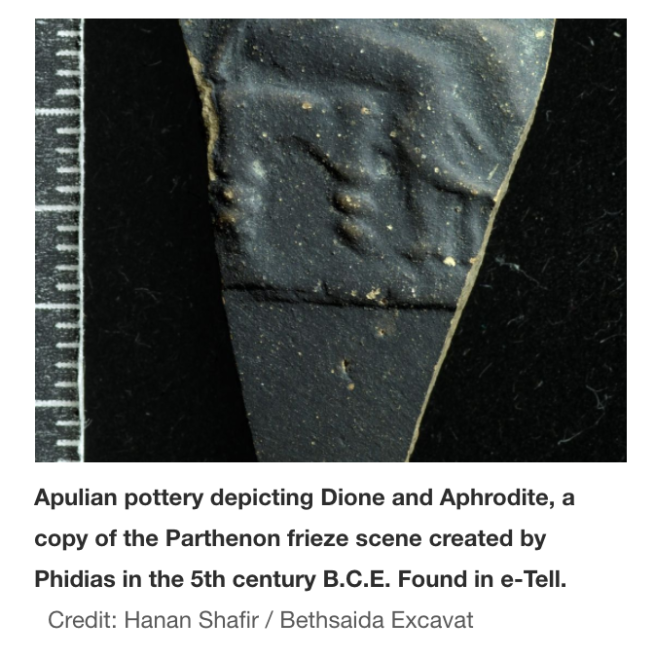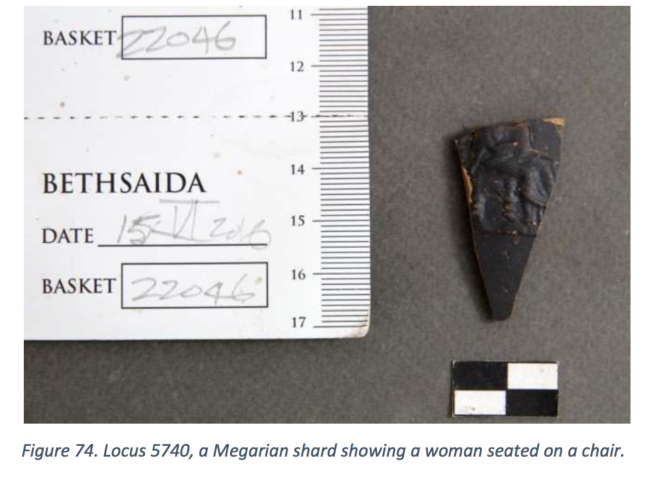[This is a in-a-rush post-in-progress, so it may have a few updates before the end of the day.]
It was with great excitement (and confusion) last night when I read the Ha’aretz headline: Archaeologists Uncover Pottery With Parthenon Scene in Biblical Village
Here are the salient details:
A pottery vase found in northern Israel turns out to show the birth of the goddess Athena, an image apparently copied from the frieze of the Parthenon in Athens. Made in Italy 2,300 years ago and found with other luxuries, the imported ceramic sheds new light on the wealth of the inhabitants of e-Tell – the site of biblical Geshur, and, later, possibly, the town of Bethsaida.
[…]
The extraordinary vase had been found among the ruins of the Galilean village a few years ago. It was decorated in unmistakable Apulian style, characteristic of southern Italy. But it is only now, using sophisticated imaging tools and complex software, that Dr. Stefany Peluso with the help of the expeditions photographer, Hanan Shafir, could identify the scene shown on the vase, which has been dated to the 4th century B.C.E.The shard shows the nymph Dione and goddess Aphrodite looking on as the goddess Athena is born, springing full-grown – and fully equipped with spear and shield – from the head of her father Zeus.
The richly decorated potsherd is one of very few surviving copies of the eastern pediment of the Parthenon, the grand marble temple that was erected after the Persian wars, in honor of Athens’ protective deity. […]
There is a lot of filler in the article, including commentary on the Parthenon and photos of other things which don’t really add to the identification of the piece itself. There is a small photo on the left hand side of the web version … here’s a screenshot for now:

As most folks who have taken a Greek pottery class will probably immediately say (as did I), Is that Apulian ware? It sure didn’t look like it to me, but perhaps the photo represents the product of ‘sophisticated imaging tools’?
A useful clue in the article was mention that the sherd was found a few years ago. The dig at ‘Bethsaida’ used to be the focus of the University of Nebraska under the direction of Rami Arav (remember? there was an Antony and Cleo coin found there a few years ago (photographed by the same person photographing this bit of pottery)), but recently they did not get a renewed permit, for whatever reason.
Whatever the case, the name of the photographer and the ‘few years ago’ suggested to me there might be a report of the find in a University of Nebraska field report (all online here). Bingo! On page 52 of the 2016 Field Report:

As can be seen, the archaeologists at the time identified it as a piece of Megarian Ware, which makes more sense, given its molded, and not-red-figure appearance. It was already identified as a ‘seated woman’. So the ‘Apulian’ designation seems to be wrong. What also strikes me as being wrong is any association with the Parthenon. There simply isn’t enough there to get ‘Aphrodite and Dione’, much less to get ‘birth of Athena’ (I doubt the ‘sophisticated imagery’ adds more), and practically nothing to distinguish this as a scene from the Parthenon, as if some artist in Apulia or Megara would put that on a pot. I ain’t convinced.

I wonder if they were simply recycling an old news story (or two, and mixing up the details and images) to fill in space…